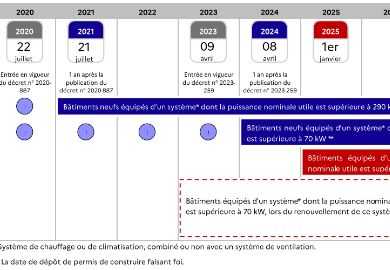What is the BACS decree?
THE BACS Decree (Building Automation and Control System) is a French regulation that requires the installation of automation and control systems (BMS) in non-residential tertiary buildings. This measure aims to improve the energy efficiency of these buildings. It has been in force since July 21, 2021.
Who is affected by the BACS decree?
The BACS Decree concerns the non-residential tertiary buildings in France . This includes structures such as offices, shops, public establishments and other similar facilities.
The aim is to improve the energy efficiency of these buildings by encouraging the use of automation and control systems
What are the objectives of the BACS decree?
Improving energy efficiency

The decree aims to encourage the installation of automation and control systems in non-residential tertiary buildings. These systems allow for more intelligent energy management, thus reducing unnecessary consumption.
Reduction of greenhouse gas emissions

By optimizing the use of equipment (lighting, heating, air conditioning, etc.), the decree contributes to the protection of the environment by limiting greenhouse gas emissions.
Financial savings for owners
By reducing energy consumption, commercial building owners can save money on their electricity and heating bills.
Modernization of buildings
The decree aims to modernize the infrastructure by equipping it with automated technologies, thus improving its operation and sustainability.
What are the deadlines for the BACS decree?

* Heating or air conditioning system, combined or not with a ventilation system.
** The date of filing of the building permit is authentic.
New Buildings (nominal power of equipment greater than 70 kW):
From April 2024 (date of submission of the building permit), new buildings must be equipped with energy management systems.
Existing Buildings (nominal power of equipment greater than 290 kW):
By January 2025 at the latest, existing buildings must comply with the decree by installing an energy regulation system.
For existing buildings with a rated power greater than 70 kW, the deadline is no later than January 2027.
Download the BACS decree guide
For more information on the BACS decree, you can download the guide below
What are the advantages of LoRaWan within the framework of the BACS decree?
LoRaWAN plays a crucial role in the context of the BACS decree through its ability to effectively address the challenges of energy efficiency. Let's see why:
Complement your existing supervision
If you already have an existing supervision, LoRaWan sensors can link to it because our gateways support the protocol BACNet
Low cost data collection
LoRaWAN enables low-cost, low-power energy and environmental data collection.
Extended coverage
With its extended range and efficient penetration inside buildings, the LoRaWAN network ensures connectivity of IoT devices in hard-to-reach areas.
Optimization of energy consumption
Data collected via LoRaWAN helps identify consumption trends, inefficiencies, and energy-saving opportunities. Building managers can use this information to optimize heating, ventilation, air conditioning (HVAC), and lighting systems, in alignment with the objectives of the BACS decree.
Reducing carbon emissions
By facilitating more efficient energy management, the implementation of a LoRaWAN contributes to reducing the energy consumption and greenhouse gas emissions of tertiary buildings, helping companies to comply with environmental regulations and achieve their sustainability objectives.
Examples of Lorawan application cases for energy optimization
Indoor air quality monitoring

Installation of LoRaWAN sensors to continuously measure indoor air quality, including CO2, humidity, and fine particles. This data can be used to automatically adjust ventilation systems, ensuring healthy air while optimizing energy consumption.
AM103
AM30x
Intelligent lighting management

Use of LoRaWAN presence and brightness sensors to adjust lighting based on actual space occupancy and natural light conditions. This helps reduce energy consumption from unnecessary lighting.
WS202
WS502
WS52x
Optimization of heating and air conditioning (HVAC) systems

LoRaWAN temperature and humidity sensors enable precise monitoring and regulation of heating, ventilation and air conditioning according to actual needs, avoiding energy waste.
VS13x
UC100
UC300
WT101
WT201
WT301
Energy consumption monitoring

LoRaWAN smart meters can be installed to measure the energy consumption of different systems and devices in the building. This data helps identify areas where improvements can be made to reduce consumption.
EM300DI
Predictive maintenance of equipment
Using LoRaWAN sensors to monitor the status of critical equipment (such as boilers, heat pumps, and ventilation units) can prevent outages and service interruptions, while optimizing energy performance.
Discover our Lorawan sensors for building management
Smart irrigation of green spaces

For commercial buildings with green spaces, LoRaWAN soil moisture sensors can precisely control irrigation, saving water while maintaining the health of plants.

